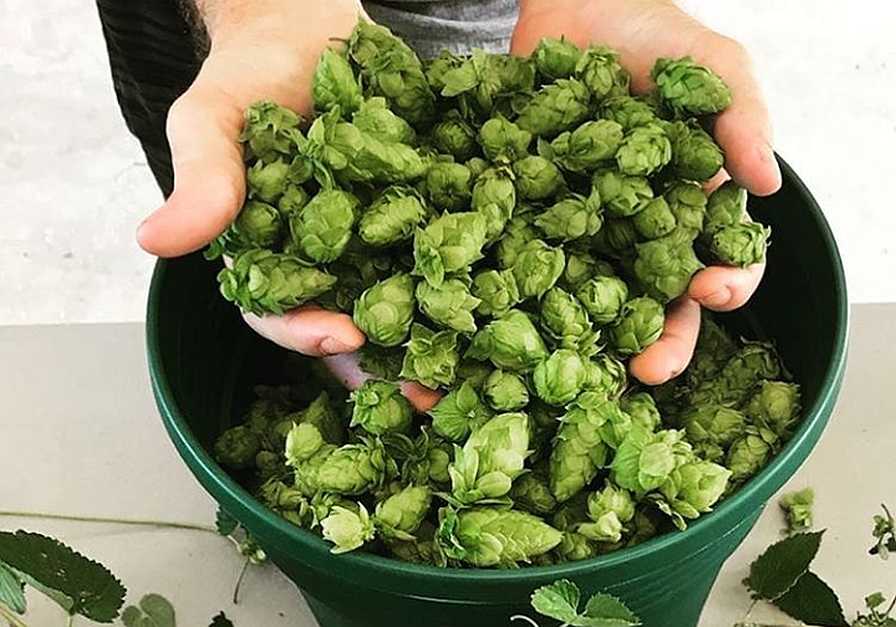Double Harvest Potential Makes Florida Hops Twice as Nice

Acreage of hops is slowly, but steadily growing in the Sunshine State. Photo courtesy of Central Florida Hops
It is projected that nearly 40 acres are being used to grow hops in Florida. Of that acreage, one quarter acre hopyard, Central Florida Hops in Zellwood, completed its first harvest this summer, sending hundreds of pounds high-quality, wet Florida-grown ‘Cascade,’ ‘Zeus,’ and ‘Comet’ hops, among others, to breweries and home brewers throughout the state.
Among the nearly 300 breweries in Florida, craft breweries, such as Tactical Brewing Co. in Orlando, Wolf Branch Brewing Co. in Eustis, Infinite Ale Works in Ocala, Central28 Beer Company in DeBary, Bowigens Beer Company in Casselberry, Robot Brewing Co. in Boca Raton, Dissent Brewing Company in St. Petersburg, Wop’s Hops Brewing Company and Deviant Wolfe Brewing (both in Sanford), were able to brew the nation’s first wet-hopped beers of the year.
For many of these breweries, this would be the first time they’ve crafted wet-hopped beers. These breweries and several others, as well as dozens of home brewers, currently represent the largest distribution of hops from a Florida hopyard.
Work from the USDA Horticulture Laboratory and the UF/IFAS Indian River Research and Education Center in Ft. Pierce also sent hops out from research hopyards to local breweries. Pareidolia Brewing Company in Sebastian and Sailfish Brewing Company in Ft. Pierce, using varieties such as ‘Willamette,’ ‘Cascade,’ and ‘Nugget’ have made some of the first wet-hopped and Florida-hopped beers seen on the Treasure Coast. Sailfish Brewing produced enough of its Picos Pale Ale, made with Florida hops, to put gallons of the beer on distribution, making it the first and only Florida-hopped beer ever to be circulated through craft beer’s three-tier system.
It has been quite an exciting year so far for this specialty crop. Throughout the state, growers are forming partnerships with breweries to produce locally grown hops for wet-hopped beers. Strengthened by breakthroughs in cultural practices from private and public organizations, hops continue to stir interest throughout the Southeast U.S.
In traditional production areas such as Oregon, Washington, and Idaho, as well as the largest non-traditional production environment of Michigan, and others areas such as North Carolina and Virginia, hops are only able to be harvested once a year, typically during late summer and early fall months. However, given Florida’s unique environment, hops can still be planted in late summer and then harvested well into late November and early December.
Growers are calling this second crop Florida’s “Holiday Hops.”
The potential for production over multiple harvests in the same year has Florida growers making the Sunshine State a fundamentally different arena for hop production. It also has given Florida breweries the opportunity to make extremely unique beers for craft beer lovers, providing additional support for growth and development of local economies.
Yields are still considerably lower than traditional production environments, yet the second harvest of hops comes at a time, like our first harvest, when there are no fresh or wet hops available as most production in traditional environments have ceased before the end of September. This prospect gives growers and brewers an advantage in continuing to meet market demand for locally produced products with another highly desired and distinctly different crop through locally produced wet- and fresh-hopped beers.
Though temperatures are in favor of Florida growers, another, more significantly impactful factor, is not.
Hops require photoperiods more than 13.5 hours; and during the fall months, many parts of Florida average less than 11 hours of light per day. Research conducted by Florida Hops LLC, USDA, and UF/IFAS have each separately indicated that hops will respond positively to photoperiod manipulation, either through extension or light interruption, with increased growth and yield, even allowing growers the potential to control and time cone production. Lighting and photoperiod manipulation would most likely be a requirement to produce viable yields during this second season.
Interestingly enough, this will be the first-year research or commercial hopyards that have attempted to produce an additional crop of hops within the same year in Florida using photoperiod manipulation. Given the sensitivity of hops to respond biochemically to changes in environmental factors, the terroir of “Holiday Hops” are expected to produce their own unique flavors and aromas, further developing and deepening the characterization of fresh Florida-hopped beers.










